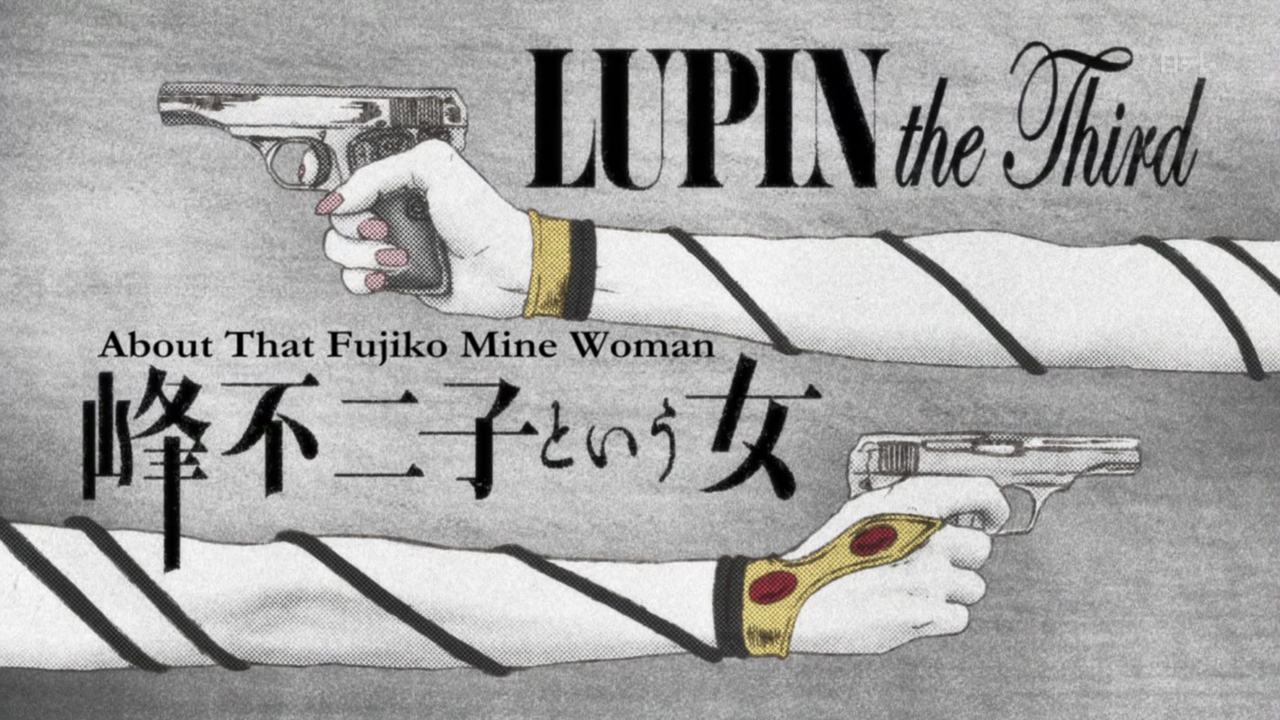![]() This interview was posted on the website Tower on December 19, 2012. Originally published in intoxicate vol.101 (December 10, 2012). The interview has been translated by Twitter user @karice67 and cofunded by @NaChiKyoTsuki97 © 2017 Wave Motion Cannon
This interview was posted on the website Tower on December 19, 2012. Originally published in intoxicate vol.101 (December 10, 2012). The interview has been translated by Twitter user @karice67 and cofunded by @NaChiKyoTsuki97 © 2017 Wave Motion Cannon
You can support the translators who you see on WMC by pledging on Patreon!
Lupin III: The Woman Called Fujiko Mine has attracted lots of attention as the first Lupin III TV series in 27 years. The individual responsible for its soundtrack is Naruyoshi Kikuchi. Though this is a spinoff with Fujiko Mine as the heroine and protagonist, it is precisely because the maestros Takeo Yamashita and Yuji Ohno gave birth to “Lupin Jazz” that we are now keen to find out about the new blood that Kikuchi, the maverick of the Jazz world, has poured into the mix. And on the other hand, we have series director Sayo Yamamoto. Tag-teaming with Music Producer Shin’ichirō Watanabe on the soundtrack of Michiko & Hatchin (2008), her debut work as a director, she asked the Brazilian musician Alexandre Kassin to create the musical score. Her creativity in bringing the sound and the visuals together saw this up-and-comer breathe a new style into the anime world. What kind of music did these two luminaries drape the world of Fujiko Mine in? Interview & text by Yasuo Murao.
The visuals that I’d come up with were completely blown away after I listened to the music.
I imagine that composing the soundtrack for a Lupin III series must be a huge responsibility. Did you feel any pressure over it?
Kikuchi: Because the title is associated with a particular nationality, it got quite a reaction from everyone around me. If I had to describe just how big it was, well, even the person in charge of the elevator at the Shin-Bungeiza movie theater in Ikebukoro knew about it—they told me “Mr. Kikuchi, I’ve heard that you’re doing the soundtrack for Lupin III” (chuckles). I deeply respect both of my predecessors, and it is Master Ohno’s unprecedented exploits that produced the Latin-esque hard bop that is known as “Lupin Jazz.” But since this series was a spinoff, I didn’t even think of trying to draw a line “from Yamatake through Ohno to Kikuchi,” and so I was able to work on it in a pretty carefree manner.
(To Yamamoto) As the director, had you intended to entrust the music to someone new right from the start?
Yamamoto: That’s right. In order to present a spinoff, I felt that it was really important for the music to be different. On top of that, I felt that I wanted to entrust it to some hooligan who had absolutely no interest in anime, so when Watanabe-san (Shin’ichiro Watanabe, who also serves as a Music Producer for Fujiko Mine) put Kikuchi-san’s name forward, I just went “This is the guy I need!” (chuckles)
In terms of the soundscape, what did the two of you discuss?
Yamamoto: The stage for this particular story was from the mid-60s to the mid-70s, so I told him that I wanted music that fit within that era.
Kikuchi: Or to be precise, there was to be “no step recording”. Even if I used a computer, it was to sound as if it were being played by hand. Watanabe-san also told me to do it as if I were recording my own album.
And how did you feel about the music when you first heard it?
Yamamoto: The first song that came in was the theme, ‘New Wuthering Heights,’ and it was absolutely wonderful. I actually felt that it would be a waste to box it in by adding the visuals, and that stayed my hand for a while. But in the end, the finished animation became something that I’d never seen before—I would say that it was the music that showed me that imagery.
It was something that even you had not envisioned.
Yamamoto: It was indeed. I did have ideas about what I wanted to see prior to hearing it, but they were completely blown away once I listened to that song.
Kikuchi: I hope it wasn’t misleading (chuckles).
Yamamoto: Not at all (chuckles), all of the staff in the studio were really surprised.
I thought that I was the only person that could work on the music.
It was surprising that you went with narration as opposed to a song for the opening.
Yamamoto: I had this conversation with Watanabe-san about not really being fond of songs, and he suggested, “Well, how about something spoken?” which I found to be interesting, and that’s basically how it happened. And Kikuchi-san said that some kind of composition would be interesting, so I pretty much pushed it onto him, like “I’ll leave the lyrics to you.”
Kikuchi: The order she placed for the narration was “something that could stand alone as a piece of music, but which also hinted at what the series was about.” Because of that, I figured that it’d be good to have someone other than the person playing Fujiko. And when I thought about who would be fitting, Takami-kun (Kazuki Takami, from East Works Entertainment) whispered in my ear “Ichiko Hashimoto” and I just went “You’re an absolute genius!” (chuckles). Hashimoto-san’s voice doesn’t give off that anime vibe, like, she’s not a professional voice actor. In Jean-Luc Godard’s Histoire(s) du cinéma, you suddenly hear people other than the actors speaking suddenly, don’t you? The impression you’d get is of something foreign, and the words represent the perspective of an adult woman, so I felt that Hashimoto-san’s voice had the aura to capture all of that.
Hashimoto-san also voices a character with an important role at the end of the series, doesn’t she? Was that something that was decided after she recorded that narration?
Yamamoto: Yes, that’s right. It was something we decided afterwards. But when we actually met her, she gave off a vibe that didn’t seem out of place for Lupin (chuckles). I’m glad that we asked her to do it.
For the score, what elements of Lupin Jazz were you conscious of, if any?
Kikuchi: I didn’t really have it in mind as I worked. But because I was aiming for a soundscape that reflected the decade from the mid-60s to mid-70s, there are elements that sound similar just by coincidence.
Like the whistling and scat singing that Yamashita-san also had?
Kikuchi: When Watanabe-san gave me directions for the music, stuff like “whistling” was already noted down in the music memo.[1] The memo was just really, really detailed (chuckles). For example, there were notes like “In a lonely manner, but not too sorrowful,” and “With a Fender Rhodes piano and guitar.” I was like, “They’re specifying it right down to which instruments I should use.” There are musicians who would ignore such directions to a certain extent and just do it in their own style, but I’m not one of them, so I just created the music according to what the higher-ups ask for.
(To Yamamoto) And with Watanabe-san, you selected the music to match the animation.
Yamamoto: I left the selection of the music to Watanabe-san. He’s someone who chooses the songs that would sound the coolest, so I tend to use pretty much all of the songs that he picks out for me. This time, too, I’m using all of the BGM he chose. I received the sound track from him and listened to it, and then checked it during the sound mixing process. Though on that note, due to a mistake, there’s some ethnic music that we weren’t able to use for the wedding ceremony scene—we’ve switched it back in for the DVD version. I’d be pleased if you would check it out!
And to what extent did Kikuchi-san’s music match the animation?
Yamamoto: It’s a bit impudent coming from me, really (chuckles), but The Woman Called Fujiko Mine feels rather classy. And I think that the music has a big part to play in that.
The role of the music is certainly very important.
Yamamoto: Indeed! If we didn’t have Kikuchi-san’s music, then The Woman Called Fujiko Mine would not have been completed.
(To Kikuchi) And what about you? How do you feel about the series now that it’s been completed?
Kikuchi: This Lupin has been made under the slogan of returning to “Lupin for adults,” and it is also “A Feminist Lupin” from the hands of a female director and a female screenwriter. The heroine carrying sexual trauma from her past going on a journey of self-discovery is a staple from the history of European film, but though it’s an anime, I realised that this show wouldn’t compromise on that psychological question one bit. It’d be something that would make men shake in their boots. So I thought that the only person that could work on the music for such a show would be me. Though I didn’t know whether I could actually pull it off. That’s why I spent some time listening to the soundtracks of (Roman Polanski’s) Repulsion and Alain Resnais’s Last Year at Marienbad, both of which deal with the theme of a woman’s sexual trauma.
I see. Dissonance is also a feature of soundtracks, isn’t it? (To Yamamoto) Finally, you spoke earlier of how “Hashimoto-san ‘gave off a vibe that didn’t seem out of place for Lupin’, but what about Kikuchi-san?
Yamamoto: I thought you’d ask that question (chuckles).
Kikuchi: Hah (chuckles).
Yamamoto: Come to think of it, the first time we met, you had this black Swarovski crystal in your ear, and it was so cute that all I could think about was where you’d bought it.
Kikuchi: I got it at the Isetan in Shinjuku (chuckles). From the ladies collection at AGATHA.
Yamamoto: I see. That’s what I really wanted to ask (chuckles).
Profiles
Sayo Yamamoto: her most representative work right now is her directorial debut, Michiko & Hatchin. She also worked on the storyboards and direction of several episodes of Director Shin’ichirō Watanabe’s Samurai Champloo. She also participated in Director Takeshi Koike’s movie-length expansion of (The Animatrix short) World Record, REDLINE, where she helped with the storyboard and was in charge of draft backgrounds.
Naruyoshi Kikuchi: Born 1963, from Chiba Prefecture. Currently active as a jazzman. With jazz as a pivot, he has expanded vigorously through a broad cross-section of music and literary writing. The proprietor of an astounding body of work, he continues to attract high level of support because of his consistent experimental bent and popularity, as well as his unique eroticism and fantastical intelligence. His latest album is DCPRG’s “Second Report From Iron Mountain USA” (impulse!).
Footnotes
[1]: The “music memo” (or alternatively, “music menu”) is basically a list of notes describing the musical tracks that the director/producer is requesting from the composer. According to Sound! Euphonium Music Producer Shigeru Saitō, a typical memo for an anime will include titles such as “fast rhythm, stringed instruments” or “everyday 1, 2, 3.” ↩


Reblogged this on ATMA & Funomena and commented:
A short greetings, readers! This is not a blog post written by yours truly, unfortunately, but I did sorta have a hand in making this interview translation happen, and it deals with a subject that I’m evidently passionate about, as well as being shamefully underappreciated by fans (AND a fair share of creators/producers if I dare say so) of film & animation.
In addition to co-funding the translation by the ever so reliable karice, I was happy to lend my help on a few technical translations of musical terms.
LikeLiked by 1 person